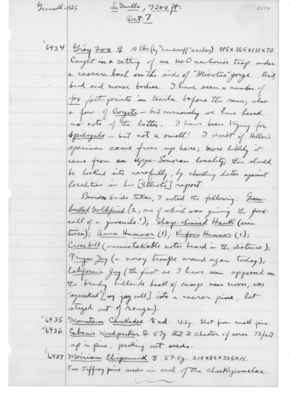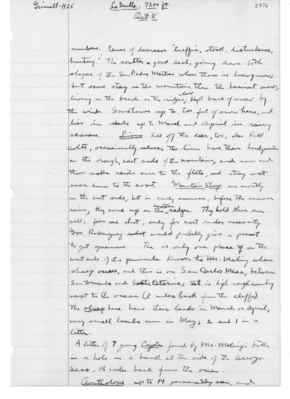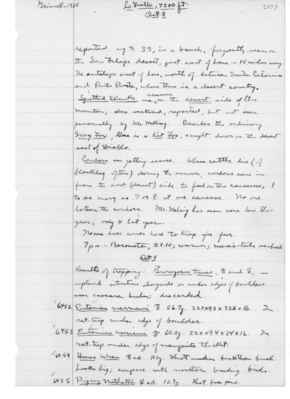Pages
S3 Page 30
Collector: Grinnell - 1925 Location: La Grulla, 7200 ft. Date: Oct. 6 Page Number: 2573
today seen at least 7 different sets of mole "ridges"--which are here only lines of cracked earth; that is, a slight raising of the wet, packed surface merely fractures it. No wonder one can see no sign of moles when the sand and gravel is dry and loose. It would appear that the "rare" San Pedro Martir mole is not so rare, after all. Only one must look for it just after a rain. 6424 Sciurus (female sign) 150g. 313x122x53x16. Shot from pine 50ft. up. 6425 Pigmy Nuthatch (male sign) ad. 12.7g. Shot from pine on dry ridge. 6426 Slender-billed Nuthatch (male sign) ad. 16.7g. Shot from pine 25ft. up. 6427 Canyon Wren (male sign) im. 11.1g. Shot on ledge of granite outcrop. Oct. 7 6428 Microtus (female sign) 70.6g. 192x55x25x12. In sawgrass. 6429 Microtus (female sign) 44g. 168x45x24x10. In sweet clover at edge of stream. Both in gorge to which cattle could not reach. Discarded: 3 Peromyscus truei, 2 (female sign), 1 (male sign); two under edges of boulders, 1 under manzanita; all on dry gravelly ground of mesa. 6430 Lutescent Warbler (male sign) ad. 7.9g. Shot in willow by stream. 6431 Lincoln Sparrow (female sign) im. 14.9g. Shot in willow by stream. 6432 Junco (male sign) ad. 18.5g. Shot from top of boulder. 6433 Intermediate Sparrow (male sign) ad. 23.8g. In open clovery place by creek; absence of one leg doubtless due to encounter with mouse trap! Barometer reading on camp table 23.15 inches; day perfectly clear, cool in shade.
S3 Page 31
Collector: Grinnell - 1925 Location: La Grulla, 7200 ft. Date: Oct. 7 Page Number: 2574
6434 Gray Fox (female sign) 10 lbs. (by "handcuff" scales). 915x365x121x70. Caught in a setting of one no. 0 newhouse trap under a cascara bush on the side of "Microtus" gorge. Bait, bird and mouse bodies. I have seen a number of fox foot-prints in trails before the rain; also a few of Coyote -- but curiously we have heard no note of the latter. I have been trying for Spilogale -- but not a smell! I doubt if Heller's specimen came from up here; more likely it came from an upper Sonoran locality; this should be looked into carefully, by checking dates against localities in his [Elliot's] report. Besides birds taken, I noted the following: Green backed Goldfinch(2, one of which was giving the food call of a juvenile; Sharp-shinned Hawk (seen twice); Anna Hummer (1); Rufous Hummer (1); Crossbill (unmistakable notes heard in the distance); Pinyon Jay (a noisy troupe around again today); California Jay (the first one I have seen appeared on the brushy hillside back of camp near noon, was "squeaked" [my jay call] into a nearer pine, but stayed out of range). 6435 Mountain Chickadee (male sign) ad. 12.2g. Shot from small pine. 6436 Cabanis Woodpecker (female sign) 57g. Shot at cluster of cones 75 feet up in pine, pecking out seeds. 6437 Merriam Chipmunk (male sign) 57.5g. 215x86x32.5x15. Two Jeffrey pine seeds in each of the cheek-pouches.
S3 Page 32
Collector: Grinnell - 1925 Location: La Grulla, 7200 ft. Date: Oct. 8 Page Number: 2575
6438 Merriam Chipmunk (male sign) 57.7g. 198x72x32x15. Shot on rock. 6439 Perognathus spinatus (female sign) 16.4g. 188x109x25x9. Trapped on damp sand under edge of willow thicket, less than ten feet from running water! Discarded: Peromyscus boylei: 1(female sign) in lush grass near edge of stream, in trap which held Microtus yesterday and 1 (male sign) under edge of boulder at cascara bush on dry upland where only P. truei had been taken previously; P. truei, 1 (male sign), under edge of boulder on dry upland. 6540 Pigmy Nuthatch (female sign) ad. 5.4g. Shot in willow. 6441 Song Sparrow (male sign) ad. 21.1g. In mouse trap under willow in "Microtus gorge". 6442 Wren-Tit (female sign) ad. 14.2g. Shot in ceanothus "buckthorn".} mates 6443 Wren-Tit (male sign) ad. 16.6g. Shot in ceanothus "buckthorn".} 6444 Solitaire (female sign) im. 32.5g. Flew from cascara bush up into pine where I shot it. The only one of this species so far seen. 6445 Fox Sparrow (male sign) im. 29.8g. Shot on rock under manzanita. 6446 Fox Sparrow (male sign) im. 29.3g. Shot in ceanothus "buckthorn". 6447 Valley Quail (female sign) 156g.}All shot from one flock, in manzanita 6448 Valley Quail (female sign) 155g.}and deer(?) brush up among the hills. 6449 Valley Quail (male sign) 173g.}There seemed to be about 40 in 6450 Valley Quail (male sign) 146g.}the flock. 6451 Valley Quail (male sign) 166g.} Interview with Salve Meling; came to this country in 1908; has been at, or with main home at, San Jose, since about 1920; in cattle business, and hence knows these mountains well. Deer drop fawns in June and July, sometimes in May; generally 2 fawns; Deer 1/2 to 1/3 now of former
S3 Page 33
Collector: Grinnell - 1925 Location: La Grulla, 7200 ft. Date: Oct. 8 Page Number: 2576
numbers. Cause of decrease "traffic, stock, disturbance, hunting." The (sic) scatter a good deal, going down both slopes of the San Pedro Martirs when there is heavy snow; but some stay on the mountain thru the heaviest snows, living on the brush on the ridges where kept bare of snow by the winds. Sometimes up to two feet of snow here, and lies in shade up to March and April in rainy seasons. Lions kill off the deer, too; also kill colts, occasionally calves; the lions have their headquarters on the rough, east side of the mountains, and now and then make raids over to the flats, and stray west even down to the coast. Mountain Sheep are mostly on the east side, but in early summer, before the summer rains, they come up on the eastern ridges. They hold their own well; few are shot, only for meat under necessity. Gov. Rodriguez would probably give a permit to get specimens. The (sic) is only one place on the west side of t(h?)e peninsula known to Mr. Meling where sheep occur, and this is on San Carlos Mesa, between San Fernando and Santa Catarina; that is high rough country next to the ocean (3 miles back from the cliffs). The sheep here have their lambs in March or April; very small lambs seen in May; 2 and 1 in a litter. A litter of 7 young Coyotes found by Mr. Meling's brother in a hole in a bank at the side of the Arroyo Seco,15 miles back from the ocean. Antelope up to 14 personally seen, and
S3 Page 34
Collector: Grinnell - 1925 Location: La Grulla, 7200 ft. Date: Oct. 8 Page Number: 2577
reported up to 35, in a bunch, frequently seen in the San Felipe desert, just east of here -- 15 miles away. No antelope west of here, north of between Santa Catarina and Punta Puerta, where there is a desert country. Spotted Skunks are common on the desert side of the mountains; also westward, reported, but not seen personally by Mr. Melling (sic). Besides the ordinary Gray Fox, there is a Kit Fox, caught down on the desert east of Diablo. Condors are getting scarce. When cattle die (of blackleg often) during the summer, condors come in from the east (desert) side to feed on the carcasses, 1 to as many as 7 or 8 at one carcass. No one bothers the condors. Mr. Meling has seen none this year; only 4 last year. No one ever comes here to trap for fur. 7 p.m. - Barometer, 23.10; warmer; mare's-tails overhead. Oct 9. Results of trapping: Peromyscus truei, (male sign) and (female sign), in upland situations alongside or under edges of boulders near cascara bushes; discarded. 6452 Eutamias merriami (male sign) 56.7g. 222x93x33.5x16. In rat-trap under edge of boulder. 6453 Eutamias merriami (male sign) 60.0g. 220x94x34x16. In rat-trap under edge of manzanita thicket. 6454 House Wren (male sign) ad. 11.1g. Shot under buckthorn bush. Looks big; compare with northern breeding birds. 6455 Pigmy Nuthatch (female sign) ad. 10.9g. Shot from pine.




